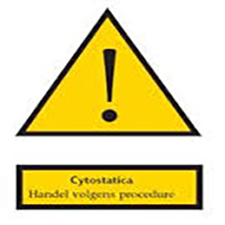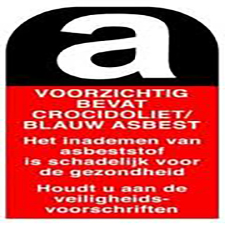Page content
Risks

Carcinogenic substances are substances that can cause cancer. Mutagenic substances can alter the genetic material. The effects of exposure may be permanent and life-threatening.
Substances used in the treatment of cancer patients and in cancer research are called cytostatics. These cytostatics themselves can also be carcinogenic.
Laboratory research uses carcinogenic and mutagenic substances such as acrylamide and ethidium bromide. Dyes in DNA research also fall into this category. Limit the use of these substances and comply with the following regulations of the Working Conditions Decree to minimise the risks:
- Only work with a carcinogen/mutagenic substance if replacement by a less hazardous alternative is not possible.
- Please explain the reason for use.
- Mark places where you work with carcinogenic substances.
- If exposure of staff is possible, you have to register them as a high-risk group.
Bij laboratoriumonderzoek worden kankerverwekkende en mutagene stoffen gebruikt, zoals acrylamide en ethidiumbromide. Ook kleurstoffen bij DNA-onderzoek vallen onder deze categorie. Beperk het gebruik van deze stoffen en houdt u aan de volgende voorschriften uit het Arbobesluit om de risico’s tegen te gaan:
- Werk alleen met een kankerverwekkende/mutagene stof als vervanging door een minder gevaarlijk alternatief niet mogelijk is;
- Beargumenteer de reden voor het gebruik;
- Markeer plekken waar met kankerverwekkende stoffen wordt gewerkt;
- Als blootstelling van medewerkers mogelijk is, dan moet u deze personen als risicogroep registreren.
Mandatory registrations
In addition to the regular registration requirements, additional requirements apply to carcinogenic and mutagenic substances. The Ministry of Social Affairs and Employment has drawn up lists of the carcinogenic substances and mutagenic substances for which the following additional registration is mandatory:
- The quantity manufactured, used or present per year;
- The number of staff who may be exposed in the workplace;
- The nature of the work carried out with the substance;
- The manner in which staff are exposed;
- The reason why use is strictly necessary and the substance cannot be replaced with a safer alternative;
- The protective measures taken.
High-risk group
If, according to the exposure assessment, work with carcinogenic and mutagenic substances poses a health hazard, you are obliged to record and retain the following data of your staff involved for at least 40 years after completion of the work:
- The personal data of exposed staff;
- Exposure data: nature, degree and duration for regular work and for incidents.
Banned substances

The following substances are prohibited:
- Solvents containing >1% benzene, carbon tetrachloride, pentachloroethane or 1.1.2.2.-tetrachloroethane in an open system;
- Solutions containing more than 0.1% of the following aromatic amines: 2-naphthylamine, 4-aminodiphenyl, benzidine, 4-nitrodiphenyl;
- 1,3-propane sultone;
- Asbestos.
